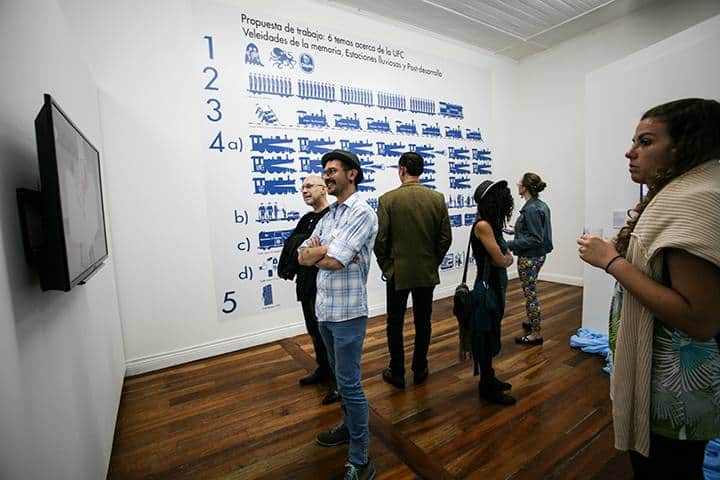For the past couple of years, the art gallery TEOR/éTica in Barrio Amón has painted and repainted its façade with large, eye-catching murals. Drivers cruising down the gallery’s San José street have seen every kind of painting, from giant Chinese characters to fantastical animals. The curators cleverly use the outside walls as part of the exhibit space, catching the attention of passersby and luring them inside.
“A Chronicle of Interventions” is by far the most provocative so far: The “mural” is a printed list of U.S. incursions in Latin America. Arranged as a timeline, the chronicle begins more than a century ago and continues to the present day. There are famous operations, like Bay of Pigs and the Invasion of Grenada. Some are more obscure. But each item is composed in English, the lettering stark and difficult to ignore.
It is significant that someone vandalized the mural shortly before the exhibit even opened, and although there has been no incident since, it is easy to believe that the image stirred some bitter feelings. The subject itself is bitter. Latin America spent half a century in violent upheaval that was largely sponsored and encouraged by outside powers. Bold U.S. claims on the region’s countries date back to the Mexican War, and the reach of U.S. imperialism in the Western Hemisphere – open and covert, economic and military – is incalculable.
TEOR/éTica is hosting “Chronicle,” a joint project with the Tate Gallery in London. The Tate is one of the most respected art edifices in the world, and it is a great testament to TEOR/éTica that the tiny gallery has earned such a big-name collaboration.
How you react to “Chronicle” depends on what role you think art should play in politics, and vice versa. Content isn’t the problem: If you visit TEOR/éTica in the near future, it is probably because you have an aversion to the CIA-backed death squads and the artificially enhanced civil wars of the 1960s-80s. You probably don’t swoon over Oliver North or Henry Kissinger. The “Chronicle” exhibit caters to English-speakers already critical of U.S. foreign policy. If you bother to see “Chronicle,” it is probably because you already share the exhibit’s perspective.
But is conceptual art a smart way to “effect change” and “seek social justice,” as human rights activists are always saying? When you see the exhibit’s flow-chart about the United Fruit Company, which explains how the corporation used its resources, is this really “art,” or is it more like a large-scale infographic? The mural, created by artists Óscar Figueroa and Andreas Siekmann, is powerful and eye-opening, but you may wonder what the difference is between this kind of art and an installation at a history museum.
In Naufύs Ramírez-Figueroa’s video, three dancers wear costumes shaped like colonial buildings while three elder men play the marimba behind them. Unless we read the artist’s statement, most of us will have no idea that the buildings represent traditional architecture in Guatemala, which has been systematically destroyed over the years. The performance art is alarming, especially when the dancers strip off their costumes and stand naked, then hurl smoke bombs into the room. Yet some patrons might find this piece both heavy-handed and pretentious. The message isn’t subtle, nor is it even comprehensible if you don’t already know its context.
TEOR/éTica accepts this risk, because the truth is, Latin America has long been a wellspring of political art, and “Chronicle” is a fine bearer of that torch. From the diehard socialist Diego Rivera to Brazil’s Theater of the Oppressed to Cuba’s many exiled poets, artists in Latin America have long demonstrated that creative expression can be a life-or-death experience. “Chronicle” takes an important message and explores it from many angles. These artists are probably not facing firing squads for their work, which is a good thing; but they are reminding us that their predecessors did. Paint the wrong fresco in the wrong country under the wrong U.S.-backed dictator, and an artist could vanish forever.
•
If you stop by TEOR/éTica, make sure to see the adjacent exhibit, “¿Y Qué Fue De Cocorí?” (“And What Happened to Cocorí?”). To understand it, you need to know about the 1947 Costa Rican novel “Cocorí,” by Joaquin Gutiérrez. Written for children, the story is a kind of folk tale about a Caribbean boy named Cocorí and a blonde girl on vacation. The story itself is fairly sweet, like a Caribbean “Little Prince,” but the novel is commonly perceived as racist and stereotypical, not unlike a minstrel show.
You’ll have to decide for yourself whether the novel itself condescends to Afro-Caribbean people, but Marton Robinson’s installation is a shocking illustration of how the media continue to represent dark-skinned Costa Ricans. Here you’ll find magazine covers, newspaper articles, antique posters, and at least one advertisement for slaves, all representing dark-skinned people in conspicuous ways. Some of the images are old, but many were printed in the past few years.
Like “Chronicle,” the message of “Cocorí” is unambiguous, especially if you have read the source material. But “Cocorí” is particularly claustrophobic, because the installation is built into a tiny, windowless room. When you see a photograph of Barack Obama and the headline “Presidente Negro,” it’s chilling, not just because of the word used to describe him, but because it suggests an exoticism, an otherness, that divides him from mainstream society. People in the U.S. must face their tortured race-relations every day. The struggle to reconcile blacks and whites in the U.S. is world-famous. But like the chronicle of interventions, we must remember that such hostility exists everywhere, even here. Robinson is courageous to say so.
“Una Crónica de Intervenciónes” continues through Feb. 22 at TEOR/éTica, Barrio Amón, San José. Free. Info: Gallery website.






